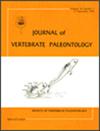Gorgonops and Endothiodon (Synapsida: Therapsida) from the Madumabisa Mudstone Formation: evidence of a previously unreported tetrapod biozone in the Mid-Zambezi Basin of southern ZambiaCitation for this article: Sidor, C. A., Mann, A., & Angielczyk, K. D. (2023) Gorgonops and Endothiodon (Synapsida: Therapsida) from the Madumabisa Mudstone Formation: evidence of a previously unreported tetrapod biozone in the Mid-Zambezi Basin of southern Zambia. Journal of …
IF 1.9
4区 地球科学
Q2 PALEONTOLOGY
引用次数: 0
Abstract
ABSTRACTFossils referable to the gorgonopsian Gorgonops sp. and to the dicynodont Endothiodon sp. are described from the Permian Madumabisa Mudstone Formation of the Mid-Zambezi Basin of southern Zambia. Specimens of the former taxon conform to recent diagnoses of the genus (e.g., five postcanine teeth, transverse flange of the pterygoid backswept, postorbital bar rugose and moderately expanded), but differ slightly from South African material in some respects (e.g., reduced dentition on the transverse flange of the pterygoid). Fossils of the latter are less complete, but show diagnostic features such as a dentary with numerous teeth, a ventral boss, and a shallow posterior dentary sulcus, oval palatine pads, and a narrow intertemporal region of the skull, although a species-level identification is not currently possible. Although the relevant fossils were never described, a vertebrate fossil assemblage including Endothiodon was previously reported from the Madumabisa Mudstone Formation in northern Zimbabwe (i.e., K5d), suggesting that this biozone was relatively broadly distributed across the Mid-Zambezi Basin. The Mid-Zambezi Basin of southern Zambia was previously demonstrated to host Guadalupian Tapinocephalus Assemblage Zone-equivalent strata, with rhinesuchids, burnetiamorphs, tapinocephalids, and dicynodonts recognized. The recognition of Lopingian Endothiodon Assemblage Zone-age rocks expands the stratigraphic range of vertebrate-bearing horizons in southern Zambia. ACKNOWLEDGMENTSOur research in Zambia has been supported by the National Geographic Society (CRE 8571-088 to S. Steyer, CRE 8961-11 to C.A.S.), with additional support from The Grainger Foundation and the Field Museum/IDP, Inc. African Partner’s Program (to K.D.A.) and NSF EAR-1337569 (to C.A.S.) and EAR-1337291 (to K.D.A. and S. Nesbitt). We thank K. Mwamulowe and J. Museba (NHCC) for assistance in arranging and carrying out the fieldwork. In addition, N. Barbolini, C. Beightol, A. Goulding, J. Museba, S. Nesbitt, R. Smith, S. Steyer, N. Tabor, and S. Tolan were part of the field teams in 2012 and 2014 and helped to collect the fossils discussed here. Preparation was skillfully performed by K. Abrams, S. Egberts, A. Shinya, and C. Van Beek. Finally, we thank M. Day, C. Kammerer, and B. Rubidge for their helpful reviews and J. Fröbisch for his editorial assistance.AUTHOR CONTRIBUTIONSCAS designed the project. CAS, KDA, and AM gathered and analyzed the data, and all three wrote and edited the manuscript.DISCLOSURE STATEMENTNo potential conflict of interest was declared by the author(s).来自Madumabisa泥岩组的Gorgonops和Endothiodon (Synapsida: Therapsida):赞比亚南部赞比西盆地中部以前未报道的四足动物生物带的证据。Angielczyk, K. D. (2023) Madumabisa泥岩组的Gorgonops和Endothiodon (Synapsida: Therapsida):赞比亚南部赞比西盆地中部以前未报道的四足动物生物带的证据。杂志…
摘要在赞比亚南部赞比西盆地中二叠纪Madumabisa泥岩组中描述了gorgonopsian Gorgonops sp.和dicynodon Endothiodon sp.的化石。前分类群的标本符合该属最近的诊断(例如,五颗后犬齿,翼状体的横向翼缘后掠,后齿条皱襞和适度扩张),但在某些方面与南非材料略有不同(例如,翼状体横向翼缘上的齿列减少)。后者的化石不太完整,但显示出诊断特征,如具有许多牙齿的牙齿,腹侧凸起,浅后牙沟,椭圆形腭垫和颅骨狭窄的颞间区,尽管目前还不可能进行物种水平的鉴定。尽管相关化石从未被描述过,但在津巴布韦北部的Madumabisa泥岩组(即K5d)中曾报道过包括Endothiodon在内的脊椎动物化石组合,这表明该生物带在赞比西盆地中部分布相对广泛。赞比亚南部的中赞比西盆地先前已被证明拥有瓜达卢普系Tapinocephalus组合带等效地层,已识别出rhinesuchids, burnetiamorphs, tapinocephalids和dicynodonts。洛平期内齿兽组合带时代岩石的发现,扩大了赞比亚南部脊椎动物层位的地层范围。致谢我们在赞比亚的研究得到了国家地理学会的支持(CRE 8571-088 to S. Steyer, CRE 8961-11 to C.A.S.),并得到了格兰杰基金会和Field Museum/IDP, Inc.的额外支持。非洲合作伙伴计划(给K.D.A.)和NSF EAR-1337569(给C.A.S.)和EAR-1337291(给K.D.A.和S. Nesbitt)。我们感谢K. Mwamulowe和J. Museba (NHCC)在安排和开展实地工作方面的协助。此外,N. Barbolini、C. Beightol、A. Goulding、J. Museba、S. Nesbitt、R. Smith、S. Steyer、N. Tabor和S. Tolan是2012年和2014年实地考察小组的成员,他们帮助收集了这里讨论的化石。准备工作由K. Abrams, S. Egberts, A. Shinya和C. Van Beek熟练地完成。最后,我们感谢M. Day、C. Kammerer和B. Rubidge的有益评论,以及J. Fröbisch的编辑协助。scas设计了这个项目。CAS, KDA和AM收集和分析数据,三人共同撰写和编辑稿件。披露声明作者未声明存在潜在利益冲突。
本文章由计算机程序翻译,如有差异,请以英文原文为准。
求助全文
约1分钟内获得全文
求助全文
来源期刊
CiteScore
2.90
自引率
7.10%
发文量
58
审稿时长
4-8 weeks
期刊介绍:
The Journal of Vertebrate Paleontology publishes original contributions on all aspects of vertebrate paleobiology, including vertebrate origins, evolution, functional morphology, taxonomy, biostratigraphy, phylogenetics, paleoecology, paleobiogeography, and paleoanthropology. JVP publishes high quality peer-reviewed original articles, occasional reviews, and interdisciplinary papers. It is international in scope, and emphasizes both specimen- and field-based based research and the use of high-quality illustrations. Priority is given to articles dealing with topics of broad interest to the entire vertebrate paleontology community and to high-impact specialist studies. Articles dealing with narrower topics, including notes on taxonomic name changes (unless these deal with errors published in JVP), preliminary site reports, and documentation of new specimens of well-known taxa, are afforded lower priority.

 求助内容:
求助内容: 应助结果提醒方式:
应助结果提醒方式:


